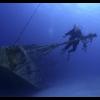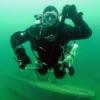Trace,
Thanks for your comments. I have a question for you. I asked the same of Geek, but he seems to have disappeared.
What kind of runtimes are you getting on those ocean dives?
I have a great deal of trouble imagining myself running out of gas with 2 AL80s on my back, and AL80 stage, and a 40cuft bottle of 50/50 in an hour. That's 240cuft of backgas. And it would make me less than 15# negative. Aluminum backplate (2#), 4hr can light (2.5#), and I'm still less than 20 pounds negative.
Why are you guys taking huge steel cylinders in the ocean? Do you really need 350+ cuft of gas for what you're doing?
Well, Perrone, as you probably know George Irvine III suggested that to "Do It Right" ocean divers should be wearing double AL80's and planning their dives with no more than 20 minutes of decompression since conditions at sea can change rapidly. I agree with this most of the time. I dive double AL80's in the ocean and I prefer a single deco gas because I have to carry it throughout the dive. I also dislike epic decompression. My idea of decompression is to be lying on a cot, drinking Gatorade and watching "Band Of Brothers" on TV while being paid $650.00 per day by the good folks at Stolt. But, since I'm not a saturation diver and I'm paying to decompress, I try to keep it short and sweet. As you know, in a cave environment I can drop bottles. I'll be leaving my O2 at 20 - 30 feet, my 50/50 at 70 - 80 feet, and my stage will get dropped after I use 1/3 of my gas. I'll dive on my back gas until I reach 1/3's, turn the dive and pick up my stage and continue until I reach my first deco gas, make the switch and then ascend on schedule switching to my final deco gas and surfacing. I'm also in fresh water and therefore heavier from a lift standpoint. But, when I mentioned some ocean dives require more gas, let's look at a couple of profiles:
This could be the gas plan for an Andrea Doria dive at 200 feet:
Off gassing starts at 139.5ft
OTU's this dive: 69
CNS Total: 33.7%
154.6 cu ft Triox 21/35
17.7 cu ft Nitrox 50
10.8 cu ft Oxygen
183.1 cu ft TOTAL
This could be the gas plan for a Britannic dive at 400 feet:
Off gassing starts at 302.3ft
OTU's this dive: 138
CNS Total: 72.7%
206.0 cu ft Trimix 9/57
43.2 cu ft Trimix 17/19
37.2 cu ft Nitrox 40
22.8 cu ft Nitrox 70
36.4 cu ft Oxygen
345.5 cu ft TOTAL
Since AL 80's only have an actual capacity of 154.8 cubic feet they would just allow you to make a 20 minute dive on the Andrea Doria with a run time of 48 minutes, but wouldn't allow you to make a 12 minute dive on the Britannic with a total run time of 107 minutes.
In the case of the Doria, I'd prefer moving to PST 104's which would offer 212.4 cubic feet of gas rather than dive AL 80's if I were going to make that dive.
The reason I'm in love with caves is that I'm process oriented. I like taking my time and being able to do something I love for 2 or 3 hours rather than just for 12 minutes!
~ Trace



















